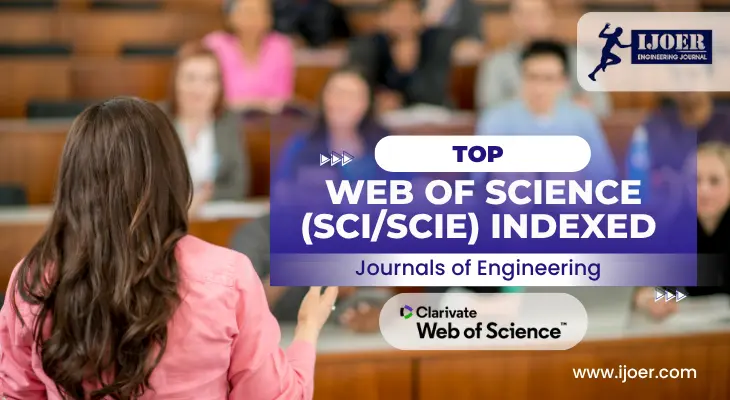
In the world of engineering research, publishing in reputable journals is more than a mark of prestige — it ensures visibility, credibility, and impact. Among various indexing platforms, the Web of Science (WoS), maintained by Clarivate Analytics, is one of the most respected. It hosts high-quality journals under SCI (Science Citation Index) and SCIE (Science Citation Index Expanded), recognized globally by universities, academic bodies, and funding agencies.
For engineers seeking career advancement, academic recognition, or global readership, publishing in WoS-indexed journals can be a game-changer.
Before diving into the top journals, it's important to understand what SCI and SCIE stand for. These classifications signify the credibility and impact of a journal in global academia.
Both are part of the Web of Science Core Collection and undergo rigorous editorial vetting and impact analysis.
If you’re planning to publish high-impact engineering research, here are some of the best SCI/SCIE-indexed journals categorized by their specializations. These journals are widely recognized and cited across academia and industry.
This journal is a go-to for researchers in industrial automation and electronics. Known for its advanced coverage of sensors, robotics, and intelligent systems, it consistently ranks among the top.
Engineering Structures focuses on all aspects of structural engineering and materials science. It is particularly useful for civil and mechanical engineers involved in design and safety.
A core journal for computer and electronics engineers, this journal features articles on embedded systems, VLSI, and edge computing.
This interdisciplinary journal links mechanical engineering with data processing. It's ideal for research on fault detection and signal interpretation.
A widely cited journal, it is perfect for engineers focusing on energy efficiency, climate resilience, and green technologies.
For civil engineers working with materials, this journal offers insights into testing, durability, and environmental performance.
A top-tier journal in aerospace engineering, covering both theoretical and applied aspects of defense and navigation systems.
This journal is excellent for engineers in software development, system design, and software validation.
A foundational journal for researchers in electrical engineering, especially in the domain of smart grids and sustainable electricity.
This journal is tailored for modern civil and structural engineers working with sensor-based technologies and smart infrastructure.
Engineers prefer WoS-indexed journals because they increase research visibility, improve career progression, and open doors to global collaborations. These journals are:
To get published in top-tier journals:
Publishing in Web of Science (SCI/SCIE) indexed journals is a prestigious achievement, but the process is often demanding. Researchers, especially early-career engineers, may face multiple challenges:
Top-tier journals have strict acceptance criteria. Rejection rates can exceed 80%, especially for papers that lack novelty, technical rigor, or real-world impact.
Peer review in SCI/SCIE journals can take anywhere from 3 to 12 months, depending on the journal and reviewer availability. This may delay academic progress or funding timelines.
Each journal has its own detailed submission guidelines. Adhering to citation styles, ethical policies, and structural formatting adds complexity to the submission process.
While many SCI/SCIE journals offer open access, publication charges (APCs) can be very high, ranging from $1,000 to $4,000 or more, which may not be feasible for all researchers.
Non-native English speakers often struggle with academic writing standards, which can affect clarity, tone, and the chances of acceptance, even if the research is strong.
If you're facing challenges publishing in Web of Science journals but still want visibility, credibility, and quality peer review — IJOER (International Journal of Engineering Research and Science) offers a reliable alternative.
IJOER provides a strong platform for engineers across disciplines to publish original research. While not SCI/SCIE indexed, it is widely recognized for:
By choosing IJOER, researchers gain a platform that values accessible and impactful research dissemination — bridging the gap between ambition and opportunity.

|
Citation Indices
|
All
|
Since 2020
|
Citation |
2359 |
1680 |
h-index |
19 |
15 |
i10-index |
57 |
24 |
|
Acceptance Rate (By Year)
|
|
|
Year
|
Percentage
|
|
2023
|
9.64%
|
|
2027
|
17.64%
|
|
2022
|
13.14%
|
|
2021
|
14.26%
|
|
2020
|
11.8%
|
|
2019
|
16.3%
|
|
2018
|
18.65%
|
|
2017
|
15.9%
|
|
2016
|
20.9%
|
|
2015
|
22.5%
|